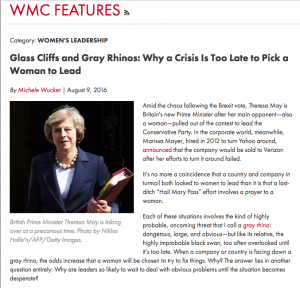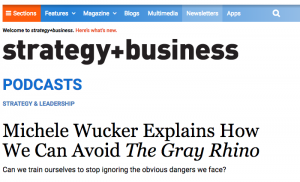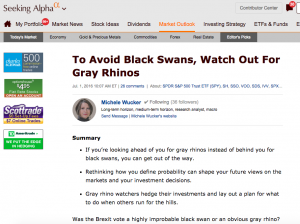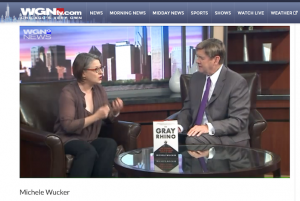Prime Minister Theresa May in Great Britain and CEO Marissa Mayer at Yahoo are two examples of women brought in to lead in extremely trying circumstances. It’s no more a coincidence that a country and company in turmoil both looked to women to lead than it is that a last-ditch “Hail Mary Pass” effort involves a prayer to a woman. But if companies and governments brought in women earlier, to both boards and leadership positions, they likely would do a much better job avoiding probable but neglected gray rhino crises. Waiting until it may be too late misses key opportunities to handle gray rhinos before they charge. Read my perspective at the Women’s Media Center.
Author: Michele Wucker
HuffPost: Trump – RINO or Gray Rhino?
![PHOTO BY GAGE SKIDMORE. HTTPS://WWW.FLICKR.COM/PHOTOS/GAGESKIDMORE [CC BY-SA 2.0 (HTTP://CREATIVECOMMONS.ORG/LICENSES/BY-SA/2.0)], VIA WIKIMEDIA COMMONS](/wp-content/uploads/2016/07/Donald_Trump_2016-300x296.jpg)
Many of Trump’s foes within the GOP have complained that Donald Trump is a RINO (Republican in Name Only), who does not hew to conservative principles. That may be true, but he’s not just a RINO. He’s a classic example of what I call a gray rhino: a big, obvious threat that we are all too likely to neglect or outright ignore until it’s too late.
The Republican presidential candidate’s inflammatory statements and encouragement of bullying have left many Americans terrified over what’s happening to our democracy. World leaders have compared him to Hitler and Mussolini and called him everything from an idiot to a demagogue to a threat to peace.
Some pundits have described the loose-tongued business mogul’s initial popularity as an outlier black swan event, referring to Nassim Nicholas Taleb’s 2007 book about the unpredictable events that can sideswipe us. But once enough people recognize that something can happen, by definition it is no longer a black swan.
Unlike the highly improbable black swan seen only in hindsight, gray rhinos are obvious risks that all too often are poorly (if at all) addressed until they are charging straight at you. Unlike the elephant in the room, gray rhinos move fast. Crucially, they give us a choice: act or get trampled.
Trump’s campaign has tapped into an entire crash (the zoologically correct term, appropriately enough) of gray rhinos: a polarized, paralyzed government; a breakdown in democracy and civil discourse; dramatic changes in the labor market; the increasing concentration of wealth and power in the hands of the few; and, as might be expected, rising social and political unrest. Both white working-class voters and minority populations feel neglected and disrespected.
Basic civility, compromise and constructive engagement have fallen to the wayside, replaced by bullying, insults, race-baiting, and candidates comparing the size of their you-know-whats. Too many Americans feel that they lack the power to change things for the better. Some have dropped out of the political process altogether. Others are drawn, like moths to a flame, to strong-arm leadership and revolution, reminiscent of Latin American caudillismo, with no evidence of concrete plans to keep their promises.
Trump’s takeover of the GOP is a classic example of how the five stages of a gray rhino unfold, from denial to muddling to diagnosing to panic to action. Understanding these stages can help to understand how to face a threat staring us in the face.
Early denial of the idea that Trump could become the GOP presidential nominee was more than understandable in the summer of 2015. But as he gained momentum over the fall, denial quickly ceded to muddling: recognition that the problem existed, but failure to diagnose the problem or present a solution, much less act decisively.
By Fall 2015, Republican campaign strategists were worried enough that they drew up a “ProtectUSA” plan to stop him. But no donors took them up on it. In February, Republican governors met to talk about how to prevent the increasingly real possibility of a Trump nomination. In March, they laid out a 100-day plan to derail his campaign. In April, Ted Cruz and John Kasich announced a plan to cooperate against Trump. But it was all too little, too late.
When his last rival dropped out and Trump became the presumptive Republican nominee, the political establishment entered the fourth stage of a Gray Rhino crisis: full blown panic. Panic ought to create the impulse to action. In this case, the action the party chose was to let itself be trampled.
We’re at a new inflection point, for both the GOP and the general public.
The GOP will have to decide if the party can be rebuilt. Trump’s GOP does not seem to be ready to deal seriously with the issues that created his fan base, nor with cross-cutting fault lines within it: between those who believe the party can only survive if it is more inclusive and those who want to bring it back to the 1950s but without the optimism; and between those who believe in more trickle-down policy for the one percent and those who are sincere in their believe in growth and entrepreneurialism.
By choosing a smaller tent and utterly refusing to act presidential, Trump may be his own gray rhino.
For its part, the Democratic Party has a choice of how to deal with Trump between now and November. To stop Trump, it must face head on the obvious but neglected issues that helped to create him.
The first challenge is to avoid the GOP’s first pitfall: denial. Surely America could not possibly elect as president a bully who insults Muslims, Mexicans, women, and disabled people; who has dragged the campaign rhetoric to a high school level; and who has told so many flat-out lies and half-truths that Politifact has called his accumulated statements its 2015 Lie of the Year?
Yet millions of voters across the United States have supported him. The website Five Thirty Eight puts the odds of a Trump win at about one in three. Recall that the odds of a Brexit were just 17 percent only months before 52 percent of British voters chose to leave the European Union. A Trump win is not impossible.
Hillary Clinton is hardly muddling or complacent in the face of Trump, out-fundraising him and making it hard to ignore his less attractive traits. The Democratic Party’s full strategy will become more apparent at its upcoming national convention.
Trump may come with a silver (or is it faux gold?) lining by giving America the shake-up that it needs. Indeed, his candidacy itself has sparked a sense of urgency and soul-searching, if not yet full-blown panic, that suggests the Democrats are more likely than the GOP to act successfully than capitulate.
But even if there were no Trump, America’s underlying gray rhinos would still be there. Unless Americans succeed in addressing those issues, we will be flattened, whether by Trump or otherwise.
strategy+business: Talk My Book
When I was in New York City recently, I sat down with Dan Gross to record the inaugural “Talk My Book” podcast on strategy+business, talking about how to avoid gray rhinos. Listen HERE.
Seeking Alpha: From Black Swans to Gray Rhinos
Was the Brexit vote a highly improbable black swan or an obvious gray rhino?
Read my thoughts on Seeking Alpha July 1, 2016, to find out.
The Gray Rhino on The Exchange
I sat down with Reuters Breakingviews US Editor Jeffrey Goldfarb for a conversation on The Exchange about why it’s more important to look for gray rhinos than black swans and how to keep from getting trampled. The interview aired June 23, 2016. Click the image below to view the video.
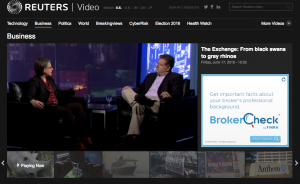
Carnegie Council Gray Rhino Podcast

It’s always great to collaborate with the team at the Carnegie Council for Ethics in International Affairs in New York City. Recently I spoke about “Move Over Black Swan: Here Comes the Gray Rhino” on June 14th, 2016, and as always was delighted by the great turnout and thoughtful conversation. You can read the transcript and listen to the podcast HERE.
The Gray Rhino on WGN-TV Midday Fix
I had a great time talking about THE GRAY RHINO with Steve Sanders on WGN TV’s Midday Fix June 6, 2017. We covered a range of gray rhinos, from Chicago’s finances to the 2008 financial crisis to climate change to the things we ignore in our personal lives.
Watch by clicking on the image below:
Observer: Why We Ignore Obvious Dangers
In this Year of the Gray Rhino, I wrote for the New York Observer about how issues that are anything but the unexpected have sideswiped the Democratic and Republican parties:
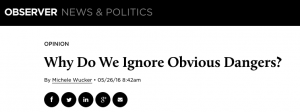 This year’s presidential campaign is full of the unexpected. Yet the underlying issues are anything but. It’s hardly news that middle- and working-class incomes have stagnated and that Americans are fed up with a government that even squabblesover an impending public health crisis like Zika. Why, then, have the country’s two leading parties been taken aback by voters who are mad as hell and not going to take it anymore?
This year’s presidential campaign is full of the unexpected. Yet the underlying issues are anything but. It’s hardly news that middle- and working-class incomes have stagnated and that Americans are fed up with a government that even squabblesover an impending public health crisis like Zika. Why, then, have the country’s two leading parties been taken aback by voters who are mad as hell and not going to take it anymore?
It’s because everyone—not just politicians—underestimates the power of the obvious problems that loom right in front of us. So it’s a surprise when inaction creates unpleasant consequences. The Democratic and Republican parties are learning this lesson the hard way.
The truth is that we get into most trouble when we’ve ignored obvious problems. I call these issues “gray rhinos” because they are huge and charging right at us and ought to be harder to ignore. Yet we miss the most important information—like calling rhinos black and white even though they are all gray.
Read the full article at observer.com
